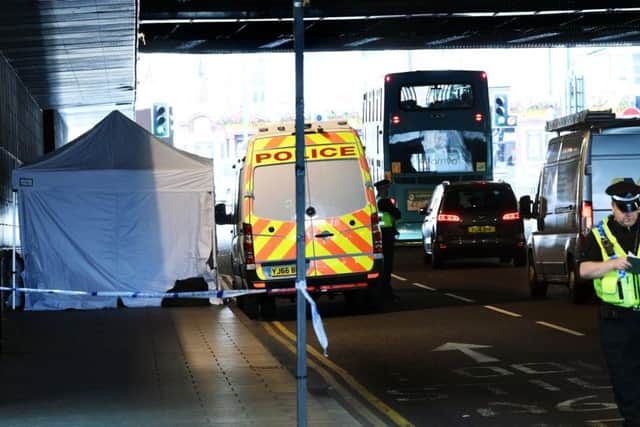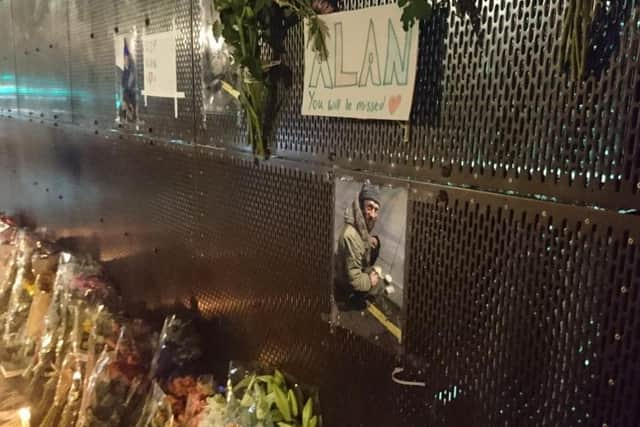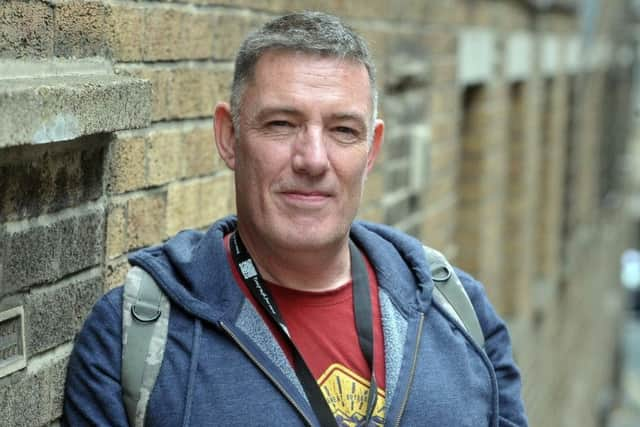Sixteen homeless deaths on region's streets in 12 months - as rough sleeping numbers rise
Yards from the entrance to Leeds Railway Station and the upmarket waterside bars and restaurants of Granary Wharf, dozens of mourners gathered for a candlelit vigil to pay their respects to two homeless men following their deaths within a week of each other. “Rest in peace angels,” one tribute read. “We will never forget our friends Alan and Geordie. Always in our hearts and minds.”
But their deaths in October 2017 – coming only days after another homeless man was found dead in a shop doorway in York – have not been the last among the region’s homeless. At least 15 people have died on the streets or in hospital in the last 12 months, with six deaths in Leeds, two in York and others in Sheffield, Barnsley, Wakefield, Hull, Grimsby and Eston on the North Yorkshire-Teesside border. A 16th homeless person died in April when he took his own life in a hostel in Leeds.
Advertisement
Hide AdAdvertisement
Hide AdAmong the deaths were a man in his 30s thought to have frozen to death in a field near Barnsley, a 65-year-old pensioner found close to the tent where he lived near Leeds and a man who collapsed in Hull after taking the increasingly-prevalent drug Spice. In Leeds, Spice-related emergency calls to the police have increased from around 16 per month in September 2017 to 66 per month by July this year.


No official organisation currently counts homeless deaths across the UK so for the past year, The Bureau of Investigative Journalism has been working with local journalists, charities and grassroots outreach groups to come up with a first-ever nationwide count.
In the past year, its ‘Bureau Local’ division has identified 449 deaths across the country of people living as homeless, including rough sleepers, those in temporary accommodation like hostels and B&Bs, or those long-term sofa-surfing. The Bureau believes the true figure is ‘significantly higher’ than what it has counted.
Jon Sparkes, chief executive of homeless charity Crisis, says: “To think of just one person dying due to the consequences of poverty and homelessness is appalling, but to learn of the sheer scale of those who’ve lost their lives in the past year is nothing short of horrifying. This is a wake-up call to see homelessness as a national emergency.
Advertisement
Hide AdAdvertisement
Hide Ad“We know that sleeping rough is dangerous, but this investigation reminds us it’s deadly. Those sleeping on our streets are exposed to everything from sub-zero temperatures, to violence and abuse, and fatal illnesses. The magnitude of this loss affects each and every one of us because it reflects on our society and on our system for letting it happen in the first place. Not only has it happened, but troublingly, it has happened unchecked.”


The Dying Homeless project has now prompted the Office for National Statistics to request access to the database in order to use the findings to help produce their own estimates on homeless deaths. The ONS will be producing its own estimates on homeless deaths and hope to release details later this year.
While Yorkshire and the Humber has the lowest proportion of rough sleepers in the whole country – of 0.09 people per 1,000 households compared to highest figure in London of 0.31 – the estimated number of rough sleepers in the region has increased by 32 per cent from 157 in 2012 to 207 last year, with rises in Leeds, York, Sheffield and Hull.
However, in contrast with the national picture where there has been an eight per cent increase in the number of people officially classified as homeless over the same five years, there has been a 41 per cent decrease in the number of people in this situation across the region.
Advertisement
Hide AdAdvertisement
Hide AdFor those on the frontline, there is some hope things may start to improve both nationally and locally. In August, the Government launched an ambitious £100m strategy designed to halve rough sleeping on England’s streets by 2022 and end it altogether by 2027.


The key focus will be to stop people becoming homeless in the first place by helping people in crisis into long-term accommodation.
In Leeds, a review has been ordered into rough sleeper deaths in the city and a new partnership approach to both supporting those in need on the city’s streets, combined with tackling related begging and anti-social behaviour, was launched last month.
A council report into the Safer Leeds Street Support team said many people on the streets have complex needs including mental health and substance misuse problems, “often connected to personal circumstances including abusive childhoods, family breakdowns, violence, debt and job loss”. The council report added there is “always” supported accommodation available to those who need it and that around 100 people have come off the streets since August 2017 as a result of a ‘Housing First’ strategy that gives rough sleepers priority when bidding for available council houses.
Advertisement
Hide AdAdvertisement
Hide AdBut the report notes that getting people off the streets can be a complex task.
“For many street users this lifestyle offers them an extended social network and becomes their community; they do not want to be isolated in a tenancy on their own as when they are on the streets they can make connections, form relationships and be part of an extended community. Some become entrenched; they form strong social groups on the streets in the face of really difficult living conditions, and the only focus of each day is survival. The days become weeks and months, and the idea of re-entering mainstream society is firmly to the back of their minds. When professionals try to help to bring some structure and organisation into their lives, it can take many attempts to succeed and the biggest obstacle is not always about providing a home.
“It is also important to stress that some of the people on the streets of the city centre, including some of those with sleeping bags and tents, are not homeless but are begging, often to feed an addiction. Often some members of the public with good intentions will give money to street users, and may feel they have helped someone with immediate needs but without knowing the consequences, i.e. it may feed a dependency, such as drugs or alcohol. This maybe a short-term fix but what we do known is it takes more than money to turn a life around.”
Gordon Laing, general manager of the Simon on the Streets charity which serves Leeds, Huddersfield and Bradford and offers emotional and practical support to rough sleepers and is independent of the new partnership project, says there are many different factors behind why people end up on the streets.
Advertisement
Hide AdAdvertisement
Hide Ad“There are lots and lots of reasons people end up on the streets but the over-arching one is poverty. Relationship breakdown is a big one, especially with middle-aged people who can’t afford a property. People will often sofa-surf with friends and family but you can’t do it forever and you could end up on the streets.
“I know of someone who was living with their mother in a council property in her name and when she died, he was left with nowhere to live. Mental health is another issue - people with mental health problems might not be able to maintain a property and pay their bills.
“The obvious is dependency [on drugs and alcohol]. But I would say it doesn’t put people on the streets, it helps keep them on there.”
He says he is “not surprised” by the Bureau’s figures on deaths among the homeless.
Advertisement
Hide AdAdvertisement
Hide Ad“The figures are going up as the figures for the number of people living that lifestyle are going up so they are sadly going to be in tandem.
“Being a rough sleeper is obviously very bad for you. A lot of people who move on from being rough sleepers into properties will have done a lot of damage to themselves. If they pass away in a property at an early age, their cause of death may be related but they are not classed as living on the streets. Cases like that will never be captured.”
However, Laing says he is hopeful the situation may improve as a result of the new national strategy.
“It is being recognised as a problem and the Government is finally pulling its finger out. I think they are doing it because of public pressure. They have realised people aren’t going to stand by and watch what is happening and they have to do something. There will always be people who don’t engage. But for the vast majority, hopefully services will be there for them.”
Advertisement
Hide AdAdvertisement
Hide AdPaul Money, chief officer of Safer Leeds, says there is a current lack of national leadership on the issue. “Because there’s no centralised co-ordination, it’s difficult to identify where the good practice is, where we can join up services. The other Core Cities are all saying the same kind of thing. It’s the same issues of deprivation, inequality, mental health and substances. It’s manifesting itself all over the country to a lesser or greater degree.”
Money says in Leeds, they now know more than ever about the cohort of ‘street users’ who they hope the new team will engage with, including a number who present themselves as being homeless in order to get money from the public.
“They are the ones getting on the bus at 5am on a Thursday, Friday and Saturday morning, then travelling back home at 4am the next day with £200 in their pockets. We know who they are and what the intervention needs to look like for them.
“We also know the highest-risk, high-threat people who could be the next to die on the streets. It’s a very different intervention for them. We never really had that understanding before.”
Advertisement
Hide AdAdvertisement
Hide AdNational charities say they are certain there is more the Government could be doing on the issue.
Alex Bax, chief executive of mental health charity Pathway, says: “These difficult findings echo the words of homelessness clinicians: too many homeless people are dying early, in painful, tragic circumstances. Deaths on the street are only one part of the picture. Many homeless people also die in hospital and with the right broad response these deaths could be prevented.
“The Royal College of Physicians advises that any hospital caring for more than 30 homeless patients each year should have a defined plan and a homelessness protocol. New duties under the Homelessness Reduction Act now ask hospitals to identify and refer all homeless patients for housing help. But at the moment many hospital systems aren’t even set up to identify homelessness as a problem.”
“In October last year Pathway led a coalition of homelessness charities asking the Secretary of State to instruct NHS Digital to agree a common national data standard, so homeless patients can be routinely identified and supported. Pathway has spent two years showing how this could be done. We hope the NHS will now move to implement this recommendation.”
Advertisement
Hide AdAdvertisement
Hide AdHoward Sinclair, St Mungo’s chief executive, says: “These figures are nothing short of a national scandal. These deaths are premature and entirely preventable.
”The commitment, in the Government’s recent rough sleeping strategy, to ensure a formal review when someone dies while rough sleeping is crucial. In this way we will be able to identify what needs to be done, locally and nationally, to stop these tragedies.”
Government wants to make rough sleeping ‘a thing of the past’
Prime minister Theresa May has said the Government “must do all we can” to prevent people sleeping rough.
Advertisement
Hide AdAdvertisement
Hide AdSpeaking at the launch of a new homelessness strategy this summer, she said: “We recognise this is a complex issue – as well as ensuring people have somewhere to live, we have to deal with underlying problems and ultimately help people turn their lives around. The strategy will help us act to prevent rough sleeping before it happens and make sure targeted support is reaching those that need it.”
Communities Secretary James Brokenshire MP said: “It is simply unacceptable that people have to sleep on the streets and I am determined to make it a thing of the past.”
Additional reporting by Georgina Morris and Maeve McClenaghan